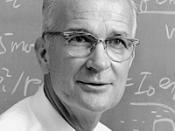In 1909 Robert Andrew Millikan set up an apparatus to measure the charge of an electron within an accuracy range of 3%. In 1913 he came out with a value of the electrical charge that would serve the world of science for a generation.
Young Millikan had a childhood like most others: he had no idea what his profession would be. Once he recalled trying to jump from a rowboat to a dock, falling in the water, and almost drowning. Here he had his first account with physics - Newton's Third Law of Motion: 'For every action there is an equal and opposite reaction'. Even in High School Physics courses Millikan was not so spirited, which may have had a little to do with his teacher's habit of spending the summers using a divining rod to find water. After Millikan graduated from Maquoketa High he was accepted into Oberlin College.
Robert actually began his physics career when he taught an elementary course at the request of his Greek professor during his sophomore year. He then transferred to Columbia University from which he graduated in 1893 as the only student graduate in physics. After this accomplishment Millikan travelled to Germany to study with such professors Planck and others. When this period was on his resume Millikan was offered a position in the Physics department at the University of Chicago and Millikan took it. After teaching for a period Millikan decided that physics could only be taught properly through the practice of experimentation and getting your hands in it just as many other things are. Thus, he began writing better textbooks for the University of Chicago, 'In fact he spent the morning of his wedding day reading proofs of his textbooks' ( http://physics.uwstout.edu/sotw/millikan.html )
During his 12 hours of teaching...


